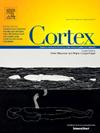Retrospective interviews reveal unawareness of weakness following reversible hemispheric suppression: An exploratory study using selective anesthesia for functional evaluation
IF 3.2
2区 心理学
Q1 BEHAVIORAL SCIENCES
引用次数: 0
Abstract
Unawareness of weakness—defined as an explicit failure to recognize one’s own limb paresis after brain damage—has long been considered predominantly linked to right-hemisphere dysfunction, yet its laterality remains controversial. We retrospectively analyzed 86 sessions of Selective Anesthesia for Functional Evaluation (SAFE) conducted in 53 patients with surgical epilepsy. SAFE involves delivering a short-acting anesthetic into a single cortical artery branch, resulting in reversible cortical suppression. Contralateral weakness was defined as a positive Barré sign in the upper limb, corresponding to a Manual Muscle Test score of <3. Following the anesthetic effect, patients were asked whether they had experienced any motor impairment. Explicit unawareness was probed using two standardized questions, followed by a limb-specific inquiry. Interviews were conducted in real-time during 28 infusions and repeated within 30 sec of motor recovery in the remaining 58 sessions. Unawareness occurred in 41 of 52 left-hemisphere infusions (78.8%) and in 26 of 34 right-hemisphere infusions (76.5%). Real-time and immediate post hoc ratings were concordant in 26 of 28 paired assessments (93%). Infusions into the M2-superior division were associated with higher rates of unawareness than those into the M2-inferior division (odds ratio = 2.3, 95% confidence interval: 1.1–5.1). Within this reversible perfusion-suppression model, the frequency of unawareness of weakness was hemispherically balanced, promoting a cautious re-evaluation of the presumed right-hemisphere dominance. SAFE provides a practical tool for isolating transient awareness deficits without structural injury and may help bridge pharmacological and lesion-based approaches to brain–behavior mapping.
回顾性访谈揭示可逆性半球抑制后的无力意识:一项使用选择性麻醉进行功能评估的探索性研究
对虚弱的无意识——定义为在脑损伤后无法明确认识到自己的肢体麻痹——长期以来被认为主要与右半球功能障碍有关,但其侧边性仍存在争议。我们回顾性分析了53例手术性癫痫患者的86次选择性麻醉功能评估(SAFE)。SAFE包括将短效麻醉剂注入单个皮质动脉分支,导致可逆的皮质抑制。对侧无力被定义为上肢barr阳性体征,对应于手动肌肉测试得分为<;3。在麻醉作用后,患者被问及他们是否经历过任何运动障碍。外显无意识是用两个标准化的问题来探究的,然后是肢体特定的询问。在28次输注期间进行实时访谈,并在其余58次运动恢复后30秒内重复访谈。52例左半球输注中有41例(78.8%)出现意识缺失,34例右半球输注中有26例(76.5%)出现意识缺失。28个配对评估中有26个(93%)的实时和即时事后评分是一致的。注射到m2上区与注射到m2下区相比,有更高的无意识率(优势比= 2.3,95%可信区间:1.1-5.1)。在这个可逆的灌注抑制模型中,意识不到虚弱的频率是半球平衡的,促进了对假定的右半球优势的谨慎重新评估。SAFE提供了一种实用的工具,可以在没有结构损伤的情况下隔离短暂的意识缺陷,并可能有助于将药理学和基于病变的脑行为映射方法联系起来。
本文章由计算机程序翻译,如有差异,请以英文原文为准。
求助全文
约1分钟内获得全文
求助全文
来源期刊

Cortex
医学-行为科学
CiteScore
7.00
自引率
5.60%
发文量
250
审稿时长
74 days
期刊介绍:
CORTEX is an international journal devoted to the study of cognition and of the relationship between the nervous system and mental processes, particularly as these are reflected in the behaviour of patients with acquired brain lesions, normal volunteers, children with typical and atypical development, and in the activation of brain regions and systems as recorded by functional neuroimaging techniques. It was founded in 1964 by Ennio De Renzi.
 求助内容:
求助内容: 应助结果提醒方式:
应助结果提醒方式:


